As a devoted cat owner, you’ve likely uttered the exasperated plea, “No, Mr. Whiskers, off the counter!” only to be met with a slow, deliberate lick of a paw, a clear sign of feline indifference. The allure of kitchen countertops is undeniable for our curious companions. It’s the hub of activity, where delicious meals are prepared, and intriguing smells linger. For a cat, these elevated surfaces offer prime observation points, a sense of security, and an irresistible playground. We can’t entirely blame them; if we were cats, we’d probably be “counter surfing” too!
The challenge isn’t just about preserving human hygiene or protecting delicate dishes; it’s about fostering a harmonious living environment. Often, cats are unfairly labeled as “jerks” for these natural behaviors, but it’s simply a matter of miscommunication between species. The good news is, you absolutely can train cats to stay off counters. The key lies in understanding their motivations and implementing positive, rewards-based training methods, such as clicker training. This approach not only discourages undesirable habits but also strengthens the bond between you and your feline friend, transforming potential annoyances into opportunities for connection and mental enrichment.
Understanding Why Cats Love Countertops
To effectively train your cat, it’s crucial to first understand the world from their perspective. For a cat, the kitchen isn’t just a place where food appears; it’s a dynamic, stimulating environment. Countertops provide a higher vantage point, fulfilling their innate desire to survey their territory from above, a behavior rooted in their predatory instincts. From this elevated position, they can observe all the household’s comings and goings, feeling safe and in control. Moreover, the scents of food, whether human meals or their own treats, are incredibly enticing. The warm spots near appliances, the intriguing textures of various surfaces, and the sheer novelty of a forbidden zone all contribute to the irresistible appeal of your kitchen counters. Simply yelling “no” or shooing them away often proves ineffective because it doesn’t address the underlying motivations or offer a compelling alternative.
The Power of Positive Reinforcement: Clicker Training Your Cat
Many years ago, I invested in a clicker and a training guide, but it sat unused for my older, seemingly “perfectly behaved” cats. They never counter-surfed, used their scratching posts, and even walked on leashes without a fuss. Then, younger, more energetic cats joined our family, and suddenly, our kitchen became their personal climbing gym. When one daring feline attempted a counter landing from the top of the fridge, resulting in crashing dishes, I knew it was time to embrace that long-forgotten clicker. This was the perfect catalyst to channel their boundless energy into something productive and teach them that working for treats could be much more rewarding than raiding the counters.
Clicker training is an excellent form of cat enrichment, offering mental stimulation that can prevent boredom and destructive behaviors. It’s a method based on positive reinforcement, where a distinct “click” sound marks the exact moment your cat performs a desired action, immediately followed by a treat. This clear communication helps your cat quickly understand what behavior earns them a reward. Beyond keeping them off counters, it’s a fantastic way to deepen your understanding of your cat’s unique personality and communication style, fostering a stronger, more positive relationship.
 A tortie cat sitting on a low perch, looking up expectantly during a clicker training session
A tortie cat sitting on a low perch, looking up expectantly during a clicker training session
Setting the Stage: Getting Started with Clicker Training
Before you begin, it’s essential to prepare your training environment to maximize your chances of success.
Establish a Dedicated Training Station
The first step is to remove any temptations from your counters. This means clearing away all food, whether human or feline, and storing treat jars in cupboards. Eliminating the very reason your cat might want to be on the counter is crucial. Next, create an alternative, more desirable “social space” in the kitchen, exclusively for your cats. This could be a set of floating shelves, a cat tree, a horizontal cardboard scratcher, or even a designated spot on a kitchen island with a comfy cat bed. The goal is to provide a place where your cat can still observe and participate in the kitchen’s excitement without being a nuisance or jumping onto forbidden surfaces. Ensure this allocated space is safe, comfortable, and appealing, making your cat feel confident and happy while perched there. We’ve found that having these designated cat zones, not too far from the main activity, allows them to feel included without being disruptive.
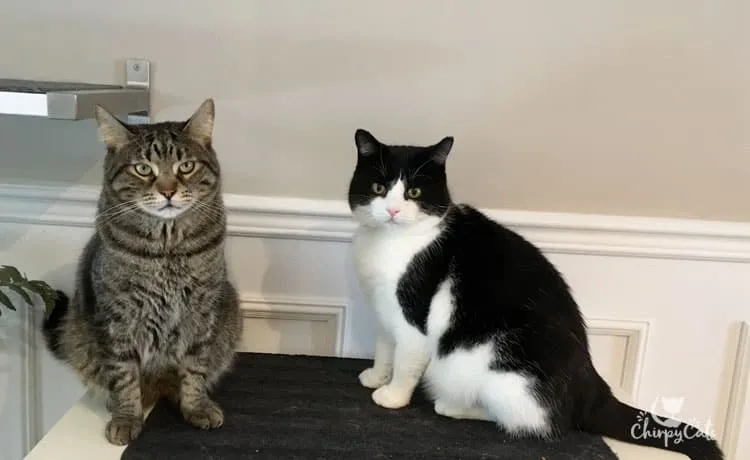 Two cats, one black and white, the other a tabby, sitting on a floating shelf in a kitchen, waiting for training
Two cats, one black and white, the other a tabby, sitting on a floating shelf in a kitchen, waiting for training
We have observed our cats readily adopting these stations, patiently waiting for their “class” to begin. Ollie and Sly Pie, for instance, often share a clicker station, while others prefer their own individual spots. The key is to keep these stations in the kitchen, integrating them naturally into the social space. This helps reinforce the idea that they are part of the action, just on their own terms. Another effective supplementary tool can be a motion-activated sprayer, which provides a harmless, consistent “no” when you’re not around, but remember this is not a solution on its own. It works best in conjunction with your positive clicker training efforts.
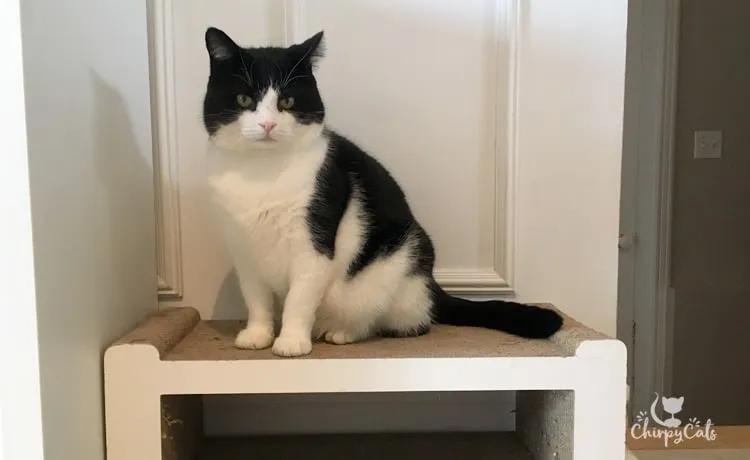 A tuxedo cat sitting calmly on a cardboard scratcher, which serves as his clicker training station
A tuxedo cat sitting calmly on a cardboard scratcher, which serves as his clicker training station
Identify Your Star Student
In multi-cat households, choosing the right cat to start with can significantly impact your success. The ideal candidate for clicker training is often the most outgoing, energetic, or even the “Chief Mischief Maker” (CMM) of the house. These are the cats who seem to be bursting with energy and are most likely to be knocking things off tables or counter-surfing. They desperately need an outlet for their innate hunting behaviors and mental stimulation. Baggins, one of our younger cats, was far more energetic than any cat I’d had in years, and both he and his brother Ollie immensely benefited from the focused activity of clicker training. Starting with such a cat can build momentum and demonstrate the process to the others.
Discover Their Ultimate Reward
Your cat needs to be motivated by something. While many cats are food-motivated, some might respond better to favorite toys, catnip, or even specific forms of affection. Experiment to find what your cat cannot resist. For food-motivated cats, consider using a portion of their daily meal during training sessions to avoid overfeeding. Our cats have become so accustomed to the routine that they often position themselves on their designated stations, waiting patiently like diligent students for their evening training class to begin, knowing delicious rewards are imminent. This anticipation demonstrates just how powerful and enjoyable these sessions can become for them.
Master the Click-and-Treat Connection
The core of clicker training begins with teaching your cat to associate the clicker sound with a positive reward. Find a quiet moment when your cat is relaxed and alert at their training station. Click once, and immediately offer a high-value treat. Repeat this a few times until your cat consistently looks for the treat after hearing the click. This establishes the click as a “marker” that signifies “good job! a treat is coming.”
Once this connection is made, you can start shaping desired behaviors. For instance, if your goal is for your cat to sit on their designated station, wait for them to perform this action. The moment their hindquarters touch the surface, click and then give a treat. Be patient and consistent. Only click and treat for the specific behavior you want to reinforce, ignoring all other actions for now. Resist the urge to reward something else just because it’s cute; this can confuse your cat. Start with one simple behavior, such as sitting, before moving on to more complex tricks like a “high five.” Soon, your cat will understand that specific actions lead to rewards, and they might even start to think they’re training you to give them treats! Always ensure training sessions are positive and never forced. If your cat is distracted or in “snooze mode,” it’s best to try again later to maintain a positive association with the training.
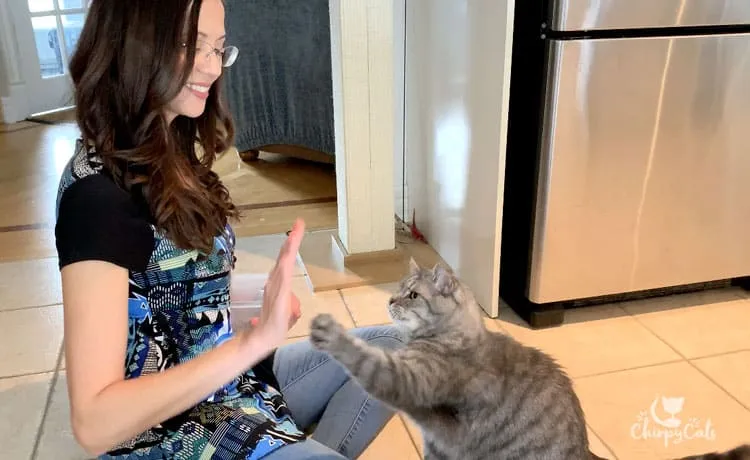 A grey tabby cat with a white chest attempting to "high five" during a clicker training session
A grey tabby cat with a white chest attempting to "high five" during a clicker training session
Training a Clutter of Cats: Group Dynamics and Observational Learning
Initially, the idea of training a “clowder” of cats simultaneously seemed daunting. I simply started with one willing participant and learned as I went. The question of whether hearing multiple clicks while “waiting in line” for treats would confuse them crossed my mind much later, but by then, brothers Ollie and Baggie had already mastered their high-fives. This proved to be an invaluable insight into feline social learning.
What I discovered is that cats are often “copycats.” Cat behaviorists refer to this as observational learning, where one cat observes the behavior of others in their group and then mimics it. While Sly Pie, Mr. Jack, and Charlie initially took longer to grasp the click-and-treat concept, I realized they weren’t uninterested; they were observing from the sidelines, taking mental notes. Sly Pie, for example, would only “sit” for treats, patiently watching the others until his turn. Then, one evening, a “lightbulb moment” occurred, and he tentatively raised his little white paw for a high five. It was a moment of pure joy, witnessing him mimic his housemates’ actions to earn his reward. Soon after, Charlie and Mr. Jack followed suit. This experience taught me that even with multiple cats, as long as one or two quickly pick up the desired behavior, the others are likely to follow, making group training more feasible than one might initially expect. Persistence and patience are key, but the results are incredibly rewarding.
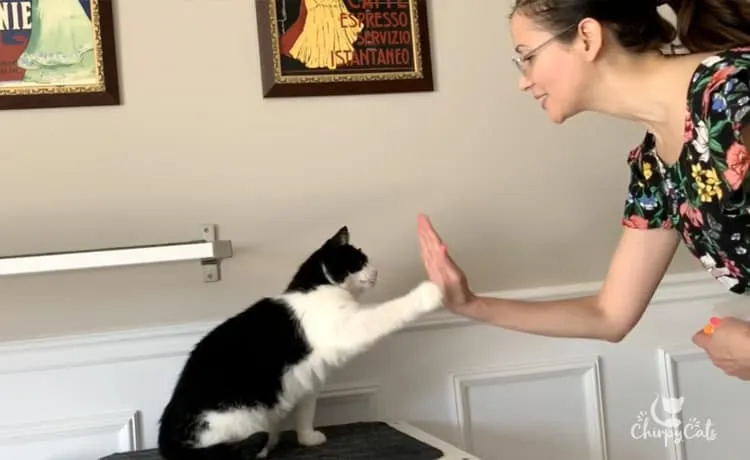 A tuxedo cat with one paw raised, attempting a "high five" during a training session
A tuxedo cat with one paw raised, attempting a "high five" during a training session
Some Cats Learn Faster Than Others
Every cat is an individual, and their learning pace will vary. Ollie, our tabby, often seems to have “kitty ADHD,” easily distracted by a bird outside or a bug on the floor. Yet, to our surprise, he became our star student in clicker training. Perhaps he simply needed something focused and mentally engaging to channel his energy. This highlights the importance of observation and tailoring your approach to your cat’s quirks.
Leveraging your “fast learner” cat, like Ollie, can be a huge advantage. They can kickstart the training momentum, unwittingly demonstrating new skills for the other cats to mimic. This indirect teaching method taps into their natural observational learning, making the process smoother for the entire group. Patience, understanding individual cat personalities, and celebrating every small success will build confidence in both you and your feline companions.
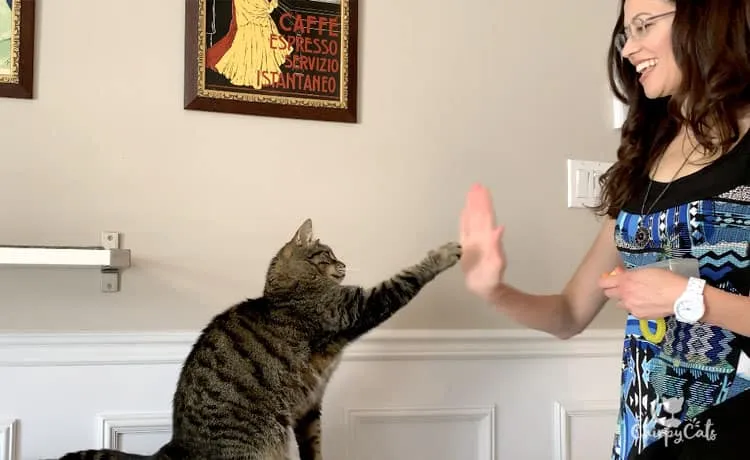 A tabby cat with one paw extended, enjoying a clicker training session and looking focused
A tabby cat with one paw extended, enjoying a clicker training session and looking focused
Beyond Counter-Surfing: The Deeper Bond of Clicker Training
Clicker training offers benefits far beyond simply keeping your cats off the kitchen counters. The very nature of the exercise — focused, positive interaction — strengthens the bond between you and your feline companions. As you engage in training, you develop a heightened sense of awareness about your cat’s unique communication cues, their subtle quirks, and their individual personalities. This deeper understanding fosters a more respectful and loving relationship.
For your cat, the rewards are immense. They receive valuable mental stimulation and enrichment by learning new tricks and engaging in focused activities. This mental workout can prevent boredom, reduce stress, and channel their natural instincts into constructive behaviors. We quickly established a nightly routine of clicker training at our cats’ dedicated kitchen stations. As a result, cooking is no longer interrupted by a clowder of begging or counter-surfing cats. When there’s no reward or benefit associated with undesirable behavior, that behavior naturally diminishes. Clicker training can also be applied to a myriad of other positive behaviors, such as encouraging them to willingly enter a carrier, making car rides less stressful, preventing them from darting out the door, or even training them to consistently use a scratching post. It’s an empowering tool that transforms how you interact with your cats, creating a more harmonious and enriching life for everyone in the household.
Incorporating Deterrents (With Caution)
While positive reinforcement is the cornerstone of effective cat training, deterrents can serve as a supplementary tool in specific situations. For instance, a motion-activated sprayer like the one by PetSafe can be deployed on countertops when you’re not actively supervising. This device provides a harmless burst of air that startles your cat, effectively delivering a “no” without you having to intervene directly. This allows the cat to associate the counter itself with the unpleasant surprise, rather than associating it with you.
However, it’s crucial to understand that deterrents are not a standalone solution. They work best in conjunction with clicker training and the establishment of attractive alternative spaces. If you only use deterrents without offering a positive alternative, your cat may simply find another forbidden surface or become anxious. The goal is to make the desired behavior (staying off counters, using their station) more rewarding than the undesirable behavior. Used judiciously and as part of a comprehensive positive training plan, deterrents can help reinforce boundaries while you focus on teaching your cat what you do want them to do.
Conclusion
Training your cats to stay off counters is not just a pipe dream; it’s an achievable goal through patience, understanding, and the power of positive reinforcement, particularly clicker training. By providing a desirable alternative space, identifying their motivations, and consistently rewarding desired behaviors, you can transform your kitchen into a peaceful cohabitation zone. This process goes beyond mere obedience; it deepens the connection with your feline friends, offers them essential mental enrichment, and builds a foundation of trust. Instead of seeing your cat as a “troublemaker,” you’ll discover a clever companion eager to learn and interact positively with you. Embrace the journey of clicker training, and you’ll not only reclaim your countertops but also foster a more harmonious and joyful home for everyone. Have you tried any rewards-based training with your cat? Share your experiences in the comments below!
